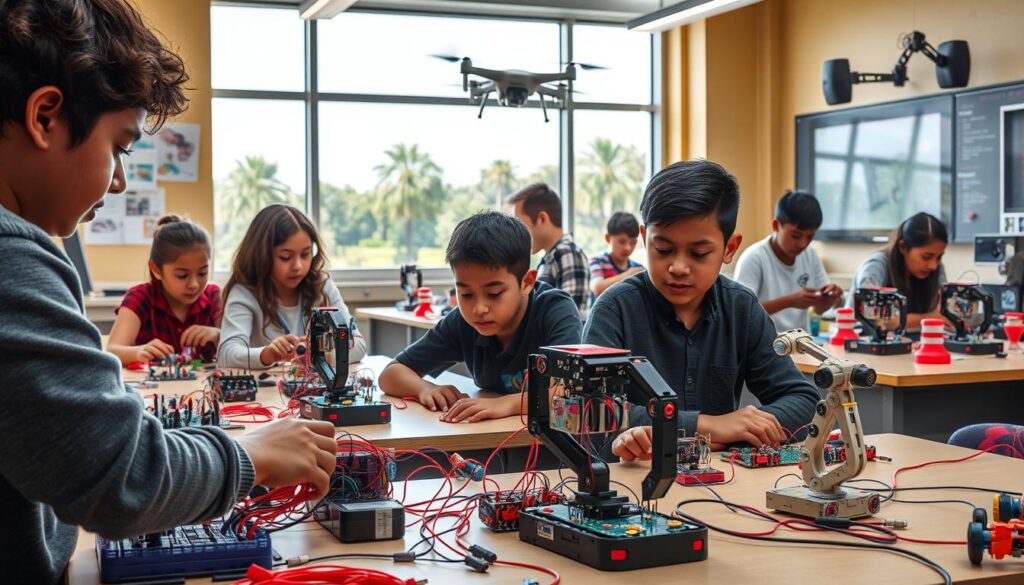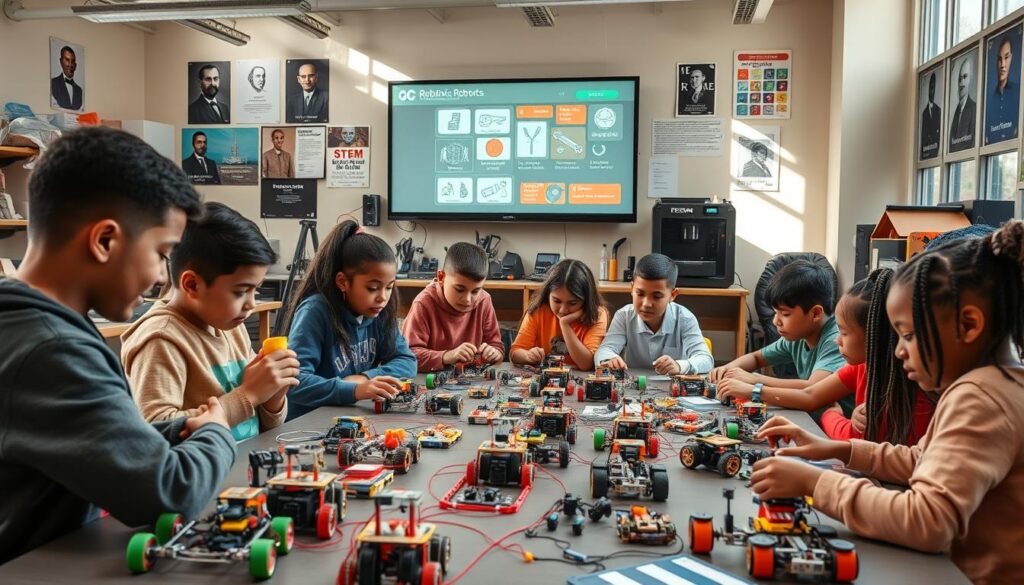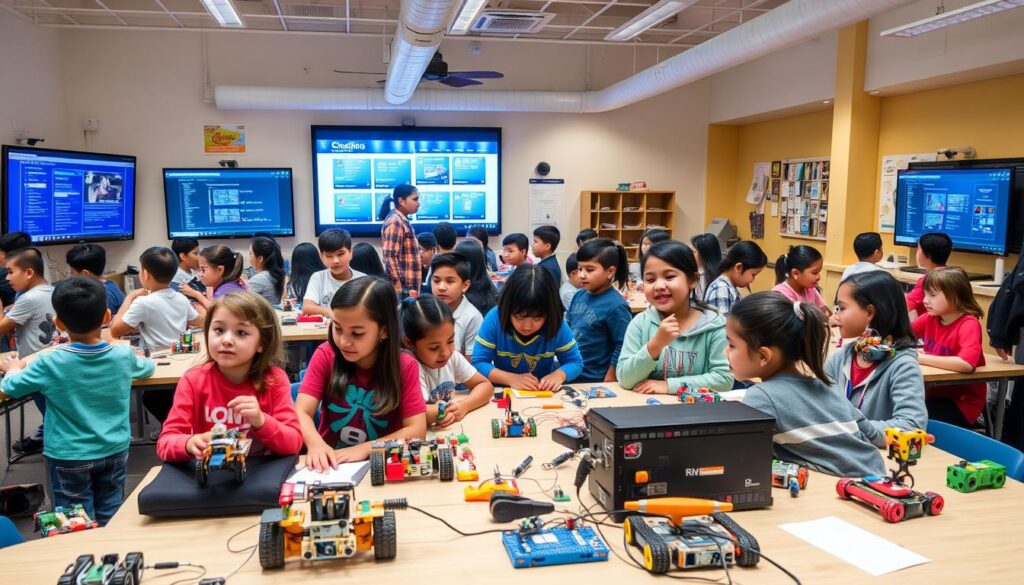Get ready for an amazing journey with our engaging robotics curriculum. It’s made to inspire and empower the next innovators in India. This hands-on learning will spark your creativity, improve your critical thinking, and open doors to exciting STEM careers.
If you’re an educator, parent, or student, you’ll see how this curriculum changes learning. It lets you dive into robotics and learn about the latest tech. You’ll also gain key skills for the 21st-century job market.

Key Takeaways
- Discover an engaging robotics curriculum that inspires creativity and innovation
- Unlock hands-on robotics learning experiences to spark your imagination
- Develop critical problem-solving and critical thinking skills for the future
- Explore the benefits of robotics curriculum for students’ STEM education
- Prepare for exciting STEM careers by mastering essential 21st-century skills
Unleash Creativity with Hands-On Robotics Learning
The robotics curriculum uses a hands-on, project-based approach. It lets students work with the latest robotics technology. They get to design, build, and program their own robots, sparking their creativity and passion for innovation.
Sparking Imagination Through Immersive Experiences
Students dive into hands-on robotics projects and enter a world of endless possibilities. They work with electronics, code, and mechanical design. This brings their ideas to life and unlocks their creative potential.
These robotics learning experiences make students feel a sense of wonder and discovery. They learn to push the limits of what’s possible.
Fostering Problem-Solving and Critical Thinking Skills
The robotics curriculum focuses on problem-solving skills and critical thinking. Students face challenges with their robots and learn to analyze problems. They come up with innovative solutions and keep going even when faced with setbacks.
This process boosts their STEM education and prepares them for the 21st-century workforce. It teaches them to tackle complex problems.
“Robotics education is more than just building machines – it’s about cultivating the mindset of a problem-solver and a creative thinker.” – Dr. Lina Sharma, Director of STEM Innovations
The Benefits of Robotics Curriculum for Students
Adding robotics to the classroom brings many benefits for students. They get to work on hands-on projects. This helps them understand STEM better, learn important 21st-century skills, and see what STEM careers are like.
Robotics classes really engage students in science, technology, engineering, and math (STEM). They design, build, and program robots. This way, they learn STEM concepts by doing, not just reading about them.
Robotics also helps students think critically and solve problems. These skills are key for success today. By tackling robotics challenges, students learn to break down problems, come up with new ideas, and work well with others.
Also, robotics education preps students for STEM careers. They get to use the latest tech. This lets them explore careers in engineering, computer science, and robotics. It opens their eyes to new possibilities and encourages them to follow their dreams.
| Benefits of Robotics Curriculum | Description |
|---|---|
| Student Engagement | Hands-on robotics projects stimulate learning and foster interest in STEM subjects. |
| 21st-Century Skills | Robotics curriculum develops critical thinking, problem-solving, and collaboration abilities. |
| STEM Career Preparation | Exposure to robotics and cutting-edge technologies prepares students for future STEM careers. |
By using robotics in schools, we can prepare students to lead in the future. They’ll have the skills and knowledge to succeed in a world that’s more tech-savvy every day.
Robotics Curriculum: A Pathway to Future STEM Careers
Introducing students to robotics curriculum does more than just spark their creativity. It also opens doors to exciting STEM career paths. By exploring robotics, students gain valuable skills like coding, engineering, and critical thinking. These are key for success in today’s workforce.
Developing Essential Skills for the 21st Century Workforce
Learning about cutting-edge technology through robotics can inspire students to pursue STEM fields. It prepares them to be innovators and leaders of tomorrow. The curriculum helps develop skills that are highly sought after in technology-driven jobs, such as:
- Problem-solving and critical thinking
- Coding and programming
- Teamwork and collaboration
- Innovative thinking and creativity
This preparation through a robotics curriculum sets students up for success in STEM careers. It gives them the tools to excel in the ever-changing 21st century workforce.
| Skill | Relevance in Robotics Curriculum | Importance for 21st Century Careers |
|---|---|---|
| Problem-solving | Students learn to analyze complex problems, devise solutions, and implement them in their robotics projects. | Problem-solving is a crucial skill in technology-driven jobs, enabling professionals to tackle challenges and drive innovation. |
| Coding and Programming | Robotics curriculum teaches students how to code and program, providing them with valuable technical skills. | Proficiency in coding and programming is in high demand across various STEM careers, as technology plays a central role in the modern workforce. |
| Teamwork and Collaboration | Robotics projects often involve working in teams, fostering communication, collaboration, and leadership skills. | The ability to work effectively in teams is crucial in the 21st century workforce, as many jobs require cross-functional collaboration. |
| Innovative Thinking | The hands-on, creative nature of robotics encourages students to think outside the box and develop innovative solutions. | Innovative thinking is highly valued in technology-driven jobs, as it drives the development of new products, services, and processes. |
By focusing on these essential skills through a robotics curriculum, you empower students for STEM careers. You also prepare them to thrive in the dynamic 21st century workforce.

Integrating Robotics Curriculum into the Classroom
Adding robotics to the classroom can change how students learn. It might also bring some early hurdles for teachers. But, with the right mindset and help from experts, schools can overcome these challenges. This way, students get the skills they need for today’s digital world.
Overcoming Challenges and Embracing Innovation
Bringing robotics into the classroom might mean teachers need to learn new things. It could also mean dealing with money issues or other problems. But, with the right strategy, these obstacles can be beaten.
One important thing is to be open to new ideas. By doing this, teachers can make learning fun and interactive. This sparks students’ interest in implementing robotics curriculum, embracing innovation in the classroom, and overcoming the challenges of robotics education.
- Provide professional development opportunities for teachers to enhance their skills and confidence in teaching robotics
- Explore funding sources, such as grants or community partnerships, to address budgetary constraints
- Collaborate with IT professionals to ensure the necessary infrastructure and technical support are in place
- Encourage a culture of experimentation and risk-taking, where both students and teachers are empowered to explore new technologies and approaches
By creating a supportive and innovative space, schools can make robotics a part of the curriculum. This helps students develop the skills they need for the future workforce.

“Robotics education is not just about teaching students how to code or build machines. It’s about cultivating the mindset and skills that will shape the future innovators and problem-solvers of our world.”
Robotics Curriculum: Empowering the Next Generation
A transformative robotics curriculum does more than teach technical skills. It empowers students to become problem-solvers, critical thinkers, and innovators. By working on hands-on projects and learning about new technology, students develop a passion for STEM.
This curriculum gives learners the confidence to face complex challenges. As they explore robotics, students gain a deeper understanding of the world. They also learn how technology can shape the future.
Through this empowering students through robotics approach, young minds are inspired to explore new possibilities. They learn to use robotics to solve real-world problems. This inspiring the next generation of thinkers and doers helps them develop important skills for the 21st-century workforce.
At the core of this transformative learning experiences is a love for STEM subjects and a desire to make a difference. By adding robotics to the curriculum, educators help students become agents of change. They drive technological advancements and help create a sustainable, equitable future.
“Robotics education is not just about building machines – it’s about building the next generation of problem-solvers, innovators, and leaders.”
As students start their robotics journey, they open up a world of endless possibilities. This curriculum prepares them to tackle tomorrow’s challenges. It inspires them to create a better future for everyone.
Choosing the Right Robotics Curriculum for Your Students
Choosing the right robotics curriculum is key. It should align with STEM standards. This ensures your students get a well-rounded education for the 21st-century workforce.
Look for lesson plans and resources that support learning. A good curriculum should make learning fun and engaging. It should also fit easily into your classroom routine.
Customizing the curriculum for your school’s needs is vital. Tailoring it to your students’ interests and learning styles can spark their passion for STEM. It helps them develop skills for the future.
When evaluating robotics curricula, consider these criteria:
- Alignment with STEM standards and learning objectives
- Availability of comprehensive lesson plans and supporting resources
- Ease of implementation and integration into the classroom
- Opportunities for customization to meet your school’s unique requirements
By choosing the right curriculum, you can unlock your students’ creativity. It fosters problem-solving and critical thinking skills. This sets them on a path to STEM careers. Robotics education empowers your students to become tomorrow’s innovators.
| Curriculum Evaluation Criteria | Importance |
|---|---|
| STEM Standards Alignment | High |
| Comprehensive Lesson Plans | High |
| Ease of Implementation | High |
| Customization Options | Moderate |
Conclusion: Embrace the Future with an Engaging Robotics Curriculum
An engaging robotics curriculum opens doors to endless possibilities. It sparks creativity, sharpens critical thinking, and leads to exciting STEM careers. This prepares you to confidently shape the future.
Through hands-on robotics experiences, you gain vital skills for today’s jobs. You learn to solve problems and work well with others. These skills are crucial in our fast-changing digital world.
It’s time to start this future-ready education. You and your peers will explore innovation and unlock your full potential. You’ll become the next generation of leaders and problem-solvers. Don’t miss this chance to change your education and create a future full of wonder.
FAQ
What is the purpose of the robotics curriculum?
The robotics curriculum aims to inspire the next generation of innovators in India. It provides hands-on experiences with advanced technology. This sparks creativity and problem-solving skills, leading to exciting STEM careers.
How does the robotics curriculum engage students?
The curriculum uses a hands-on, project-based approach. Students design, build, and program their own robots. This sparks their imagination and develops problem-solving and critical thinking skills.
What are the key benefits of the robotics curriculum?
The curriculum enhances STEM understanding and develops 21st-century skills. It exposes students to STEM careers. This prepares them for a technology-driven world.
How does the robotics curriculum prepare students for future STEM careers?
The curriculum teaches coding, engineering, and critical thinking. These skills are highly valued in today’s workforce. It inspires students to explore STEM fields, preparing them to lead the future.
What are the challenges of implementing a robotics curriculum?
Starting a robotics curriculum can be challenging. It may require new skills, budget adjustments, or logistical solutions. Yet, with innovation and collaboration, schools can overcome these hurdles.
How can you choose the right robotics curriculum for your students?
Look for alignment with STEM standards and comprehensive lesson plans. Consider the curriculum’s ease of implementation. Customize it to fit your school’s needs for a transformative learning experience.